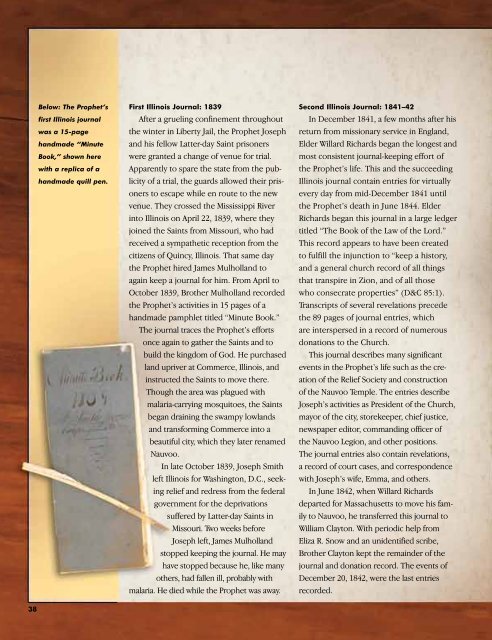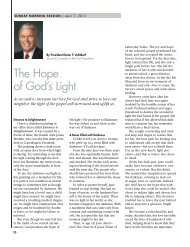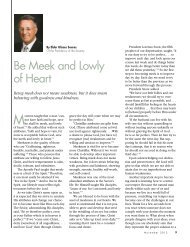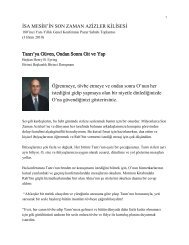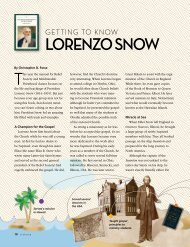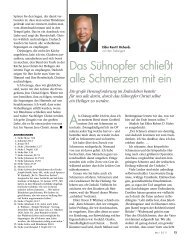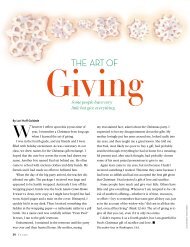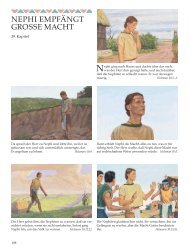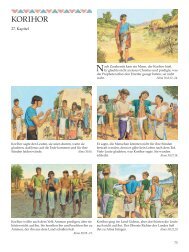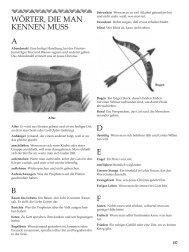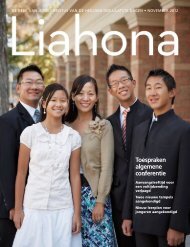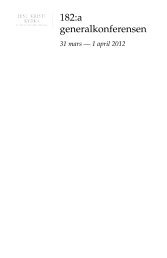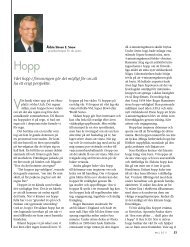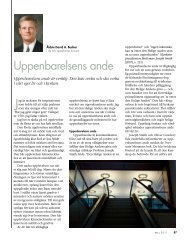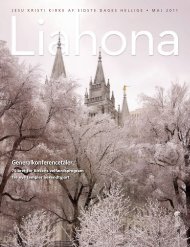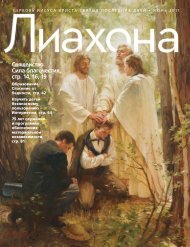December 2007 Ensign - The Church of Jesus Christ of Latter-day ...
December 2007 Ensign - The Church of Jesus Christ of Latter-day ...
December 2007 Ensign - The Church of Jesus Christ of Latter-day ...
You also want an ePaper? Increase the reach of your titles
YUMPU automatically turns print PDFs into web optimized ePapers that Google loves.
38<br />
Below: <strong>The</strong> Prophet’s<br />
first Illinois journal<br />
was a 15-page<br />
handmade “Minute<br />
Book,” shown here<br />
with a replica <strong>of</strong> a<br />
handmade quill pen.<br />
First Illinois Journal: 1839<br />
After a grueling confinement throughout<br />
the winter in Liberty Jail, the Prophet Joseph<br />
and his fellow <strong>Latter</strong>-<strong>day</strong> Saint prisoners<br />
were granted a change <strong>of</strong> venue for trial.<br />
Apparently to spare the state from the publicity<br />
<strong>of</strong> a trial, the guards allowed their prisoners<br />
to escape while en route to the new<br />
venue. <strong>The</strong>y crossed the Mississippi River<br />
into Illinois on April 22, 1839, where they<br />
joined the Saints from Missouri, who had<br />
received a sympathetic reception from the<br />
citizens <strong>of</strong> Quincy, Illinois. That same <strong>day</strong><br />
the Prophet hired James Mulholland to<br />
again keep a journal for him. From April to<br />
October 1839, Brother Mulholland recorded<br />
the Prophet’s activities in 15 pages <strong>of</strong> a<br />
handmade pamphlet titled “Minute Book.”<br />
<strong>The</strong> journal traces the Prophet’s efforts<br />
once again to gather the Saints and to<br />
build the kingdom <strong>of</strong> God. He purchased<br />
land upriver at Commerce, Illinois, and<br />
instructed the Saints to move there.<br />
Though the area was plagued with<br />
malaria-carrying mosquitoes, the Saints<br />
began draining the swampy lowlands<br />
and transforming Commerce into a<br />
beautiful city, which they later renamed<br />
Nauvoo.<br />
In late October 1839, Joseph Smith<br />
left Illinois for Washington, D.C., seeking<br />
relief and redress from the federal<br />
government for the deprivations<br />
suffered by <strong>Latter</strong>-<strong>day</strong> Saints in<br />
Missouri. Two weeks before<br />
Joseph left, James Mulholland<br />
stopped keeping the journal. He may<br />
have stopped because he, like many<br />
others, had fallen ill, probably with<br />
malaria. He died while the Prophet was away.<br />
Second Illinois Journal: 1841–42<br />
In <strong>December</strong> 1841, a few months after his<br />
return from missionary service in England,<br />
Elder Willard Richards began the longest and<br />
most consistent journal-keeping effort <strong>of</strong><br />
the Prophet’s life. This and the succeeding<br />
Illinois journal contain entries for virtually<br />
every <strong>day</strong> from mid-<strong>December</strong> 1841 until<br />
the Prophet’s death in June 1844. Elder<br />
Richards began this journal in a large ledger<br />
titled “<strong>The</strong> Book <strong>of</strong> the Law <strong>of</strong> the Lord.”<br />
This record appears to have been created<br />
to fulfill the injunction to “keep a history,<br />
and a general church record <strong>of</strong> all things<br />
that transpire in Zion, and <strong>of</strong> all those<br />
who consecrate properties” (D&C 85:1).<br />
Transcripts <strong>of</strong> several revelations precede<br />
the 89 pages <strong>of</strong> journal entries, which<br />
are interspersed in a record <strong>of</strong> numerous<br />
donations to the <strong>Church</strong>.<br />
This journal describes many significant<br />
events in the Prophet’s life such as the creation<br />
<strong>of</strong> the Relief Society and construction<br />
<strong>of</strong> the Nauvoo Temple. <strong>The</strong> entries describe<br />
Joseph’s activities as President <strong>of</strong> the <strong>Church</strong>,<br />
mayor <strong>of</strong> the city, storekeeper, chief justice,<br />
newspaper editor, commanding <strong>of</strong>ficer <strong>of</strong><br />
the Nauvoo Legion, and other positions.<br />
<strong>The</strong> journal entries also contain revelations,<br />
a record <strong>of</strong> court cases, and correspondence<br />
with Joseph’s wife, Emma, and others.<br />
In June 1842, when Willard Richards<br />
departed for Massachusetts to move his family<br />
to Nauvoo, he transferred this journal to<br />
William Clayton. With periodic help from<br />
Eliza R. Snow and an unidentified scribe,<br />
Brother Clayton kept the remainder <strong>of</strong> the<br />
journal and donation record. <strong>The</strong> events <strong>of</strong><br />
<strong>December</strong> 20, 1842, were the last entries<br />
recorded.


